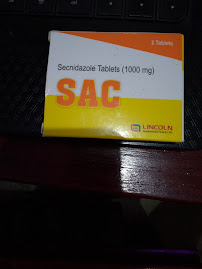SAC (Secnidazole 100mg Tablets)
SAC (Secnidazole 100mg Tablets) is a medication used to treat various types of infections caused by certain parasites. It contains the active ingredient secnidazole, which belongs to a class of drugs called nitroimidazoles. It works by disrupting the DNA of the parasites, which leads to their death. SAC is commonly used to treat conditions such as bacterial vaginosis, trichomoniasis, and amoebiasis. It is typically taken orally, with or without food, and the dosage and duration of treatment may vary depending on the specific condition being treated. It is important to follow the prescribing physician's instructions carefully when taking this medication, as improper use can lead to unwanted side effects such as nausea, headache, or dizziness. Additionally, SAC should be avoided during pregnancy and breastfeeding, unless specifically prescribed by a healthcare provider.
Secnidazole is active against E.histolytica, G.lamblia, Trichomonas vaginalis, Clostridium spp, B.fragilis, Gardnerella spp. It enters microorganisms by diffusion and is reduced intracellulary by low oxidation-reduction potential ferrodoxin which results in DNA damage.
Pharmacokinetic:
Oral secnidazole is rapidly & completely absorbed with Cmax 3 hours, elimination T 1/2 17 to 29 hours low Vd (49.2L) & 15% protein binding. It undergoes oxidation in liver. Secnidazole is eliminated via urine (50%).
Indications
For treatment of Intestinal Amoebiasis, Hepatic Amoebiasis, Urethritis and Vaginitis due to Trichomonas vaginalis and Giardiasis.
Contraindications
Contraindicated in patients with hypersensitivity to secnidazole or imidazole derivatives.
Special precautions and warnings
Avoid alcohol during treatment with Secnidazole because possibility of ant abuse effect.
Administration of Secnidazole should be avoided to patients with a history of blood dyscrasia.
Pregnancy and Lactation
Secnidazole should not be administered during first trimester of pregnancy or during lactation because Secnidazole is found in placenta and breast milk.
Dosage and directions for use
Acute Intestinal Amoebiasis and Trichomonas vaginalis: Adult 2gm single dose. Children: 30mg/kg single dose
Hepatic Amoebiasis: Adult 1.50gm/day in a single dose or divided dose for 5 days. Children: 30mg/kg/day in a single dose or divided dose for 5 days.
Giardiasis: Adult 2gm single dose. Children: 35-50mg/kg single dose.
Adverse effects
Gastrointestinal disturbances, nausea, epigastric pain, metallic taste, glossitis, stomatitis, urticaria, moderate leucopenia, vertigo, ataxia & motor incoordination, paresthesia & peripheral neuropathy.
Drug interactions
Administration of Secnidazole with disulfiram is not recommended. Use of Secnidazole simultaneously with warfarin requires close monitoring, increased effect of oral anticoagulants and of the hemorrhagic risk is likely.
Overdosage
Treatment should be supportive & symptomatic with emesis, gastric lavage, administration of activated charcoal & use of cathartics. For seizures, use diazepam or phenytoin.


.png)



0 Comments